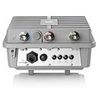-
Home
-
Contributors
-
International
-
Account
-
Information
More From Contributor
- Ease of use, scalability, & redundancy.
- Enhanced architecture for flexible network design.
- IEEE 802.11a/b/g/n AP & access device support.
- Comprehensive WLAN security.
- Appliance & blade form factors. ...
- Rate limiting: supports per-wireless client ingress-enforced maximums & per-wireless client, per-queue guaranteed minimums
- Diagnostic: client event log records association, authentication, & DHCP events;
Includes:: a packet capture tool for Ethernet & IEEE 802.11 interfaces (PCAP format), a wireless client data rate matrix, & a client status page; complete session logging provides detailed information for problem identification & resolution
- Centralized traffic: Layer 2 & Layer 3 Qo S settings are maintained when using Mobility Traffic Manager or guest access Firewall
- Stateful firewall: enforces firewall policies to control traffic & filter access to network services; maintains session information for every connection passing through it, enabling the firewall to control packets based on existing sessions
- NAT/PAT: choice of dynamic partial address translation (PAT) or static network address translation (NAT) preserves a network's IP address pool or conceals the private address of network resources, such as Web servers, which are made accessible to users of a guest or public wireless LAN
- Authenticated network access: authenticates users with an internal or external RADIUS server or Microsoft Active Directory before allowing full network connectivity Management
- Automated work flows: Initial controller settings: define basic operational settings for the controller, including network connections, security settings, & system time. Wireless network for employees: enables setup of a new wireless network for employees, including network & security settings. Wireless network for guests: provides wireless access for guest users, including network & security settings specific to guest access.
- Remote configuration & management: are available through secure Web browser, comm&-line (console port or SSH), SOAP, or SNMP
- Management interface control: allows interfaces to be enabled or disabled depending on security preferences
- Management VLAN: segments traffic to & from management interfaces, including CLI, Web browser interface, & SNMP
- RADIUS accounting support: separates RADIUS accounting server support per SSID; provides detailed session, usage, & billing information for each client activity Connectivity
- 10 Gb E connections to the switch fabric (MSM765 zl Premium Mobility controller only): two 10-Gb E wire-speed internal connections help ensure that the network connections from the application to the switch backplane will not limit application performance
- IPv 6 wireless client traffic forwarding: is supported for Layer 2 & Layer 3 mobility (MTM) & for client traffic directly bridged at the AP
- IEEE 802.3ad Link Aggregation Control Protocol (LACP) & HP port trunking (MSM720 controller only): support up to six ports bonded via LACP; support manually configured trunks between an HP switch & the controller Performance
- High-performance processor system: MSM720: Freescale Dual Core 800MHZ P1020 Processor with a 256 KB cache in an appliance designed for 10 to 40 APs. MSM760: Intel Core™ 2 Duo Processor E6400 with 2.13 GHz & 2 MB cache in an appliance designed for larger environments. MSM765 zl: Intel Core 2 Duo Processor T7500 with 2.2 GHz & 4 MB cache in a single-switch slot designed for larger chassis-based environments.
- Memory subsystems: 4/2/1 GB of memory (MSM765 (DDR2)zl/MSM760 (DDR2)/MSM720 (DDR3) provides enhanced application performance
- Disk drive (MSM76x): 250 GB SATA II 7200 rpm hard disk drive allows rapid data reads/writes, providing enhanced application performance Mobility
- Solutions enhanced for businesses: MSM7xx controllers deliver services for a range of vertical markets, including healthcare, hospitality, education, manufacturing, transportation, & service providers
- Powerful security capabilities: robust, identity- & role-based user account profiles use internalor external AAA services
- Solutions that cover the most important WLAN applications: HP MSM solutions deliver rich application support, including guest access, location-based services, Voice over Wi-Fi (Vo Wi-Fi), hotspot, surveillance, & secure point of sale
- Capacity that scales from small office to large campus: efficiently deploy wireless LANs (WLANs) with the MSM710 controller, which controls up to 10 APs; the MSM720 controller, which supports 10 to 40 APs; & the MSM760 & MSM765 zl controllers, which control 40 to 200 APs
- Premium Mobility Scalability
Features: Virtual controller: means that you can configure a team of up to 800 APs & up to five controllers (MSM76x) or 40 APs across two controllers (MSM720) managed via a single IP address. N+1 redundancy: teaming provides N+1 redundancy. Seamless failover: APs can fail-over without rebooting, which preserves network mobility services for wireless clients when the client traffic is bridged locally at the AP. 64 VSC profiles: up to 64 profiles can be defined. Security
- Secure Shell: encrypts all transmitted data for secure remote CLI access over IP networks
- Secure Sockets Layer (SSL): encrypts all HTTP traffic, allowing secure access to the browser-based management GUI in the switch
- IEEE 802.1X, Active Directory, & RADIUS network logins: control wireless network access for authentication & accountability using IEEE 802.1x, Microsoft Active Directory, & RADIUS
- RADIUS-based MAC authentication: authenticates a wireless client with a RADIUS server based on the MAC address of the client; this is useful for clients with minimal or no user interface
- Web-based authentication: provides a Web browser-based environment to authenticate clients that may not support the IEEE 802.1X supplicant ...

HP MSM720
(QoS) - Rate limiting: supports per-wireless client ingress-enforced maximums and per-wireless client, per-queue guaranteed minimums - Diagnostic: client event log records association, authentication, and DHCP events; includes a packet capture tool for Ethernet and IEEE 802.11 interfaces (PCAP format), a wireless client data rate matrix, and a client status page; complete session logging provides detailed information for problem identification and resolution - Centralized traffic: Layer 2 and Layer 3 QoS settings are maintained when using Mobility Traffic Manager or guest access Firewall - Stateful firewall: enforces firewall policies to control traffic and filter access to network services; maintains session information for every connection passing through it, enabling the firewall
to control packets based on existing sessions - NAT/PAT: choice of dynamic partial address translation (PAT) or static network address translation (NAT) preserves a network's IP address pool or conceals the private address of network resources, such as Web servers, which are made accessible to users of a guest or public wireless LAN - Authenticated network access: authenticates users with an internal or external RADIUS server or Microsoft Active Directory before allowing full network connectivity Management - Automated work flows: Initial controller settings: define basic operational settings for the controller, including network connections, security settings, and system time. Wireless network for employees: enables setup of a new wireless network for employees, including network
and security settings. Wireless network for guests: provides wireless access for guest users, including network and security settings specific to guest access. - Remote configuration and management: are available through secure Web browser, command-line (console port or SSH), SOAP, or SNMP - Management interface control: allows interfaces to be enabled or disabled depending on security preferences - Management VLAN: segments traffic to and from management interfaces, including CLI, Web browser interface, and SNMP - RADIUS accounting support: separates RADIUS accounting server support per SSID; provides detailed session, usage, and billing information for each client activity Connectivity - 10 GbE connections to the switch fabric (MSM765 zl Premium Mobility controller only): two
10-GbE wire-speed internal connections help ensure that the network connections from the application to the switch backplane will not limit application performance - IPv6 wireless client traffic forwarding: is supported for Layer 2 and Layer 3 mobility (MTM) and for client traffic directly bridged at the AP - IEEE 802.3ad Link Aggregation Control Protocol (LACP) and HP port trunking (MSM720 controller only): support up to six ports bonded via LACP; support manually configured trunks between an HP switch and the controller Performance - High-performance processor system: MSM720: Freescale Dual Core 800MHZ P1020 Processor with a 256 KB cache in an appliance designed for 10 to 40 APs. MSM760: Intel Core™ 2 Duo Processor E6400 with 2.13 GHz and 2 MB cache in an appliance designed for
larger environments. MSM765 zl: Intel Core 2 Duo Processor T7500 with 2.2 GHz and 4 MB cache in a single-switch slot designed for larger chassis-based environments. - Memory subsystems: 4/2/1 GB of memory (MSM765 (DDR2)zl/MSM760 (DDR2)/MSM720 (DDR3) provides enhanced application performance - Disk drive (MSM76x): 250 GB SATA II 7200 rpm hard disk drive allows rapid data reads/writes, providing improved application performance Mobility - Solutions enhanced for businesses: MSM7xx controllers deliver services for a range of vertical markets, including healthcare, hospitality, education, manufacturing, transportation, and service providers - Powerful security capabilities: robust, identity- and role-based user account profiles use internalor external AAA services - Solutions that cover
the most important WLAN applications: HP MSM solutions deliver rich application support, including guest access, location-based services, Voice over Wi-Fi (VoWi-Fi), hotspot, surveillance, and secure point of sale - Capacity that scales from small office to large campus: efficiently deploy wireless LANs (WLANs) with the MSM710 controller, which controls up to 10 APs; the MSM720 controller, which supports 10 to 40 APs; and the MSM760 and MSM765 zl controllers, which control 40 to 200 APs - Premium Mobility Scalability Features: Virtual controller: allows you to configure a team of up to 800 APs and up to five controllers (MSM76x) or 40 APs across two controllers (MSM720) managed via a single IP address. N+1 redundancy: teaming provides N+1 redundancy. Seamless failover: APs can
fail-over without rebooting, which preserves network mobility services for wireless clients when the client traffic is bridged locally at the AP. 64 VSC profiles: up to 64 profiles can be defined. Security - Secure Shell: encrypts all transmitted data for secure remote CLI access over IP networks - Secure Sockets Layer (SSL): encrypts all HTTP traffic, allowing secure access to the browser-based management GUI in the switch - IEEE 802.1X, Active Directory, and RADIUS network logins: control wireless network access for authentication and accountability using IEEE 802.1x, Microsoft Active Directory, and RADIUS - RADIUS-based MAC authentication: authenticates a wireless client with a RADIUS server based on the MAC address of the client; this is useful for clients with minimal or no user
interface - Web-based authentication: provides a Web browser-based environment to authenticate clients that may not support the IEEE 802.1X supplicant
This page now acts as a permanent archive for this product. Add more information using the comments box below to ensure it can still be found by future generations.
Use our search facility to see if it is available from an alternative contributor.
- Availability: Out Of Stock
- Supplier: Transparent Communications
- SKU: 1860759
Product Description
Working in unison with HP MSM access points, the HP MSM Controller Series delivers high-performance networking solutions. The enhanced architecture scales to 802.11n without requiring controller replacement. Robust identity- & roles-based user account profiles, as well as Virtual Service Communities (VSCs) with independently configurable Quality of Service (Qo S), authentication, encryption, & VLAN support, deliver intelligence to the network edge. Scalable from small to larger deployments, the MSM wireless controllers support a fast-roaming capability. Wireless security is comprehensive with support for internal & external authentication, authorization, & accounting (AAA) servers, built-in stateful firewall, per-user VLAN mapping, & authentication. Quality of Service (Qo S)
- Rate limiting: supports per-wireless client ingress-enforced maximums & per-wireless client, per-queue guaranteed minimums
- Diagnostic: client event log records association, authentication, & DHCP events;
Includes:: a packet capture tool for Ethernet & IEEE 802.11 interfaces (PCAP format), a wireless client data rate matrix, & a client status page; complete session logging provides detailed information for problem identification & resolution
- Centralized traffic: Layer 2 & Layer 3 Qo S settings are maintained when using Mobility Traffic Manager or guest access Firewall
- Stateful firewall: enforces firewall policies to control traffic & filter access to network services; maintains session information for every connection passing through it, enabling the firewall to control packets based on existing sessions
- NAT/PAT: choice of dynamic partial address translation (PAT) or static network address translation (NAT) preserves a network's IP address pool or conceals the private address of network resources, such as Web servers, which are made accessible to users of a guest or public wireless LAN
- Authenticated network access: authenticates users with an internal or external RADIUS server or Microsoft Active Directory before allowing full network connectivity Management
- Automated work flows: Initial controller settings: define basic operational settings for the controller, including network connections, security settings, & system time. Wireless network for employees: enables setup of a new wireless network for employees, including network & security settings. Wireless network for guests: provides wireless access for guest users, including network & security settings specific to guest access.
- Remote configuration & management: are available through secure Web browser, comm&-line (console port or SSH), SOAP, or SNMP
- Management interface control: allows interfaces to be enabled or disabled depending on security preferences
- Management VLAN: segments traffic to & from management interfaces, including CLI, Web browser interface, & SNMP
- RADIUS accounting support: separates RADIUS accounting server support per SSID; provides detailed session, usage, & billing information for each client activity Connectivity
- 10 Gb E connections to the switch fabric (MSM765 zl Premium Mobility controller only): two 10-Gb E wire-speed internal connections help ensure that the network connections from the application to the switch backplane will not limit application performance
- IPv 6 wireless client traffic forwarding: is supported for Layer 2 & Layer 3 mobility (MTM) & for client traffic directly bridged at the AP
- IEEE 802.3ad Link Aggregation Control Protocol (LACP) & HP port trunking (MSM720 controller only): support up to six ports bonded via LACP; support manually configured trunks between an HP switch & the controller Performance
- High-performance processor system: MSM720: Freescale Dual Core 800MHZ P1020 Processor with a 256 KB cache in an appliance designed for 10 to 40 APs. MSM760: Intel Core™ 2 Duo Processor E6400 with 2.13 GHz & 2 MB cache in an appliance designed for larger environments. MSM765 zl: Intel Core 2 Duo Processor T7500 with 2.2 GHz & 4 MB cache in a single-switch slot designed for larger chassis-based environments.
- Memory subsystems: 4/2/1 GB of memory (MSM765 (DDR2)zl/MSM760 (DDR2)/MSM720 (DDR3) provides enhanced application performance
- Disk drive (MSM76x): 250 GB SATA II 7200 rpm hard disk drive allows rapid data reads/writes, providing enhanced application performance Mobility
- Solutions enhanced for businesses: MSM7xx controllers deliver services for a range of vertical markets, including healthcare, hospitality, education, manufacturing, transportation, & service providers
- Powerful security capabilities: robust, identity- & role-based user account profiles use internalor external AAA services
- Solutions that cover the most important WLAN applications: HP MSM solutions deliver rich application support, including guest access, location-based services, Voice over Wi-Fi (Vo Wi-Fi), hotspot, surveillance, & secure point of sale
- Capacity that scales from small office to large campus: efficiently deploy wireless LANs (WLANs) with the MSM710 controller, which controls up to 10 APs; the MSM720 controller, which supports 10 to 40 APs; & the MSM760 & MSM765 zl controllers, which control 40 to 200 APs
- Premium Mobility Scalability
Features: Virtual controller: means that you can configure a team of up to 800 APs & up to five controllers (MSM76x) or 40 APs across two controllers (MSM720) managed via a single IP address. N+1 redundancy: teaming provides N+1 redundancy. Seamless failover: APs can fail-over without rebooting, which preserves network mobility services for wireless clients when the client traffic is bridged locally at the AP. 64 VSC profiles: up to 64 profiles can be defined. Security
- Secure Shell: encrypts all transmitted data for secure remote CLI access over IP networks
- Secure Sockets Layer (SSL): encrypts all HTTP traffic, allowing secure access to the browser-based management GUI in the switch
- IEEE 802.1X, Active Directory, & RADIUS network logins: control wireless network access for authentication & accountability using IEEE 802.1x, Microsoft Active Directory, & RADIUS
- RADIUS-based MAC authentication: authenticates a wireless client with a RADIUS server based on the MAC address of the client; this is useful for clients with minimal or no user interface
- Web-based authentication: provides a Web browser-based environment to authenticate clients that may not support the IEEE 802.1X supplicant
Reviews/Comments
Add New
Intelligent Comparison
Price History
We couldn't find any historical pricing!
Vouchers
Do you know a voucher code for this product or supplier? Add it to Insights for others to use.


 United Kingdom
United Kingdom
 France
France
 Germany
Germany
 Netherlands
Netherlands
 Sweden
Sweden
 USA
USA
 Italy
Italy
 Spain
Spain














 Denmark
Denmark